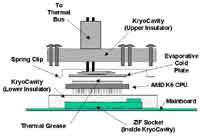Kryotech Cool K6-3 500
by Anand Lal Shimpi on March 3, 1999 9:45 PM EST- Posted in
- Cases/Cooling/PSUs
The Cool new Cool K6-3
| The Kryotech Cool K6-3 uses the same vapor phase refrigeration technology that bought the original Cool K6-2 its 15 minutes of fame. The KryoCavity allows for the processor to be isolated, then a, soon to be nickel, plate (the engineering sample AnandTech tested did not feature a nickel plate, however the shipping versions will feature one made of nickel purely to maintain a more elegant appearance) makes contact with the surface of the CPU. | |
| By transferring the heat through the thermal bus, essentially a fairly thick and barely malleable tube, from the plate, the processor itself is cooled down to approximately -40 degrees on the Celsius scale. This extreme cooling is the technology that makes Kryotech's thermal acceleration possible. | |
Removing the heat the processor introduces into the case, through the use of the KryoCavity, provides for a more stable operating environment since you don't have to worry about the presence of an extremely hot processor contributing to the growing heat problem in today's desktop computers. The only producers of heat in the case that remain are devices such as video cards and hard drives which should operate much more comfortably with the processor's heat removed from their surroundings.
At the heart of the system, chirping away inside the KryoCavity, is AMD's newly released K6-3 processor. The K6-3 used in the engineering sample AnandTech tested was a 400MHz processor, rated for operation at a 2.4v core voltage, and equipped with 256KB of on-chip L2 cache running at clock speed (as are all K6-3 processors). Because of the 400MHz clock speed of the K6-3 Kryotech used in the system, the final speed of the Cool K6-3 turned out to be 500MHz, and unfortunately the system would not run reliably enough at any major increases above 500MHz to be considered viable options. Kryotech is working on a K6-3 450 based solution as well, however the chances are that a K6-3 450 would make it up to 600MHz, at the current manufacturing yields from AMD, are very slim. At most, a 450MHz part would see the time of day at 550MHz, but that's about all unless the quality of AMD's K6-3 yields increase.
The motherboard, as alluded to previously, is the ALi Aladdin V based ASUS P5A Super7 motherboard which has already been reviewed on AnandTech. A strong solution, the P5A offers the 5/2/1 (PCI/ISA/AGP) expansion configuration most users desire as well as 512KB of on-board L3 cache for the K6-3 to make for the best performance combination possible.
Unfortunately, because of the nature of the Super7 standard, hardware/software compatibility isn't as great as we'd all like it to be, therefore if you're planning on using an AGP accelerator with the system you're going to have to pick up the latest AGP drivers and patches for the Aladdin V chipset. A sizeable oversight on the part of Kryotech is their failure to include any of the Aladdin V AGP driver or IDE Bus Master drivers at all, so if you do pick up this $1250 system you're going to have to spend a little time downloading the files off of a motherboard manufacturer's website (ASUS doesn't offer them for direct download, and it would be faster writing the drivers than trying to download them from the ALi site in Taiwan).
Just as with the original Cool K6-2 system, the Cool K6-3 turns itself on after the CPU temperature reaches a level of -36 degrees Celsius, and it happens to feature the same intelligent monitoring system which shuts the computer off if there is a failure in the cooling system. The system conveniently ships with a 1 amp fuse that controls the auto shutdown feature in the case of an emergency.











0 Comments
View All Comments